Lu Lu
DuPO: Enabling Reliable LLM Self-Verification via Dual Preference Optimization
Aug 20, 2025Abstract:We present DuPO, a dual learning-based preference optimization framework that generates annotation-free feedback via a generalized duality. DuPO addresses two key limitations: Reinforcement Learning with Verifiable Rewards (RLVR)'s reliance on costly labels and applicability restricted to verifiable tasks, and traditional dual learning's restriction to strictly dual task pairs (e.g., translation and back-translation). Specifically, DuPO decomposes a primal task's input into known and unknown components, then constructs its dual task to reconstruct the unknown part using the primal output and known information (e.g., reversing math solutions to recover hidden variables), broadening applicability to non-invertible tasks. The quality of this reconstruction serves as a self-supervised reward to optimize the primal task, synergizing with LLMs' ability to instantiate both tasks via a single model. Empirically, DuPO achieves substantial gains across diverse tasks: it enhances the average translation quality by 2.13 COMET over 756 directions, boosts the mathematical reasoning accuracy by an average of 6.4 points on three challenge benchmarks, and enhances performance by 9.3 points as an inference-time reranker (trading computation for accuracy). These results position DuPO as a scalable, general, and annotation-free paradigm for LLM optimization.
Seed LiveInterpret 2.0: End-to-end Simultaneous Speech-to-speech Translation with Your Voice
Jul 24, 2025



Abstract:Simultaneous Interpretation (SI) represents one of the most daunting frontiers in the translation industry, with product-level automatic systems long plagued by intractable challenges: subpar transcription and translation quality, lack of real-time speech generation, multi-speaker confusion, and translated speech inflation, especially in long-form discourses. In this study, we introduce Seed-LiveInterpret 2.0, an end-to-end SI model that delivers high-fidelity, ultra-low-latency speech-to-speech generation with voice cloning capabilities. As a fully operational product-level solution, Seed-LiveInterpret 2.0 tackles these challenges head-on through our novel duplex speech-to-speech understanding-generating framework. Experimental results demonstrate that through large-scale pretraining and reinforcement learning, the model achieves a significantly better balance between translation accuracy and latency, validated by human interpreters to exceed 70% correctness in complex scenarios. Notably, Seed-LiveInterpret 2.0 outperforms commercial SI solutions by significant margins in translation quality, while slashing the average latency of cloned speech from nearly 10 seconds to a near-real-time 3 seconds, which is around a near 70% reduction that drastically enhances practical usability.
FunDiff: Diffusion Models over Function Spaces for Physics-Informed Generative Modeling
Jun 09, 2025Abstract:Recent advances in generative modeling -- particularly diffusion models and flow matching -- have achieved remarkable success in synthesizing discrete data such as images and videos. However, adapting these models to physical applications remains challenging, as the quantities of interest are continuous functions governed by complex physical laws. Here, we introduce $\textbf{FunDiff}$, a novel framework for generative modeling in function spaces. FunDiff combines a latent diffusion process with a function autoencoder architecture to handle input functions with varying discretizations, generate continuous functions evaluable at arbitrary locations, and seamlessly incorporate physical priors. These priors are enforced through architectural constraints or physics-informed loss functions, ensuring that generated samples satisfy fundamental physical laws. We theoretically establish minimax optimality guarantees for density estimation in function spaces, showing that diffusion-based estimators achieve optimal convergence rates under suitable regularity conditions. We demonstrate the practical effectiveness of FunDiff across diverse applications in fluid dynamics and solid mechanics. Empirical results show that our method generates physically consistent samples with high fidelity to the target distribution and exhibits robustness to noisy and low-resolution data. Code and datasets are publicly available at https://github.com/sifanexisted/fundiff.
Capacity-Optimized Pre-Equalizer Design for Visible Light Communication Systems
May 26, 2025Abstract:Since commercial LEDs are primarily designed for illumination rather than data transmission, their modulation bandwidth is inherently limited to a few MHz. This becomes a major bottleneck in the implementation of visible light communication (VLC) systems necessiating the design of pre-equalizers. While state-of-the-art equalizer designs primarily focus on the data rate increasing through bandwidth expansion, they often overlook the accompanying degradation in signal-to-noise ratio (SNR). Achieving effective bandwidth extension without introducing excessive SNR penalties remains a significant challenge, since the channel capacity is a non-linear function of both parameters. In this paper, we present a fundamental analysis of how the parameters of the LED and pre-equalization circuits influence the channel capacity in intensity modulation and direct detection (IMDD)-based VLC systems. We derive a closed-form expression for channel capacity model that is an explicitly function of analog pre-equalizer circuit parameters. Building upon the derived capacity expression, we propose a systematic design methodology for analog pre-equalizers that effectively balances bandwidth and SNR, thereby maximizing the overall channel capacity across a wide range of channel attenuations. We present extensive numerical results to validate the effectiveness of the proposed design and demonstrate the improvements over conventional bandwidth-optimized pre-equalizer designs.
CreoPep: A Universal Deep Learning Framework for Target-Specific Peptide Design and Optimization
May 05, 2025Abstract:Target-specific peptides, such as conotoxins, exhibit exceptional binding affinity and selectivity toward ion channels and receptors. However, their therapeutic potential remains underutilized due to the limited diversity of natural variants and the labor-intensive nature of traditional optimization strategies. Here, we present CreoPep, a deep learning-based conditional generative framework that integrates masked language modeling with a progressive masking scheme to design high-affinity peptide mutants while uncovering novel structural motifs. CreoPep employs an integrative augmentation pipeline, combining FoldX-based energy screening with temperature-controlled multinomial sampling, to generate structurally and functionally diverse peptides that retain key pharmacological properties. We validate this approach by designing conotoxin inhibitors targeting the $\alpha$7 nicotinic acetylcholine receptor, achieving submicromolar potency in electrophysiological assays. Structural analysis reveals that CreoPep-generated variants engage in both conserved and novel binding modes, including disulfide-deficient forms, thus expanding beyond conventional design paradigms. Overall, CreoPep offers a robust and generalizable platform that bridges computational peptide design with experimental validation, accelerating the discovery of next-generation peptide therapeutics.
Solla: Towards a Speech-Oriented LLM That Hears Acoustic Context
Mar 19, 2025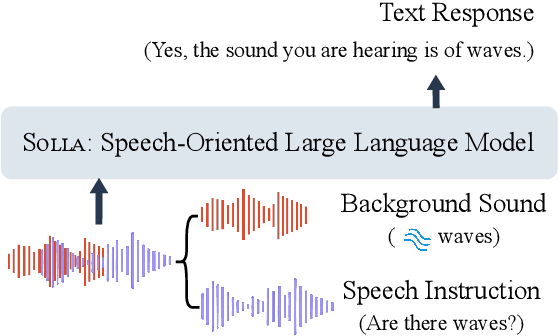

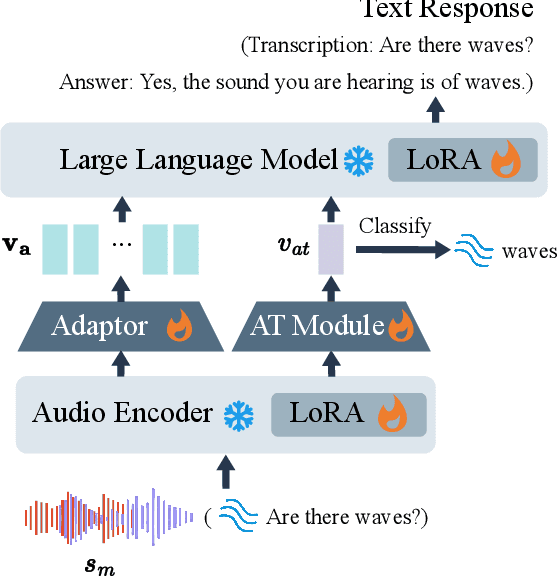
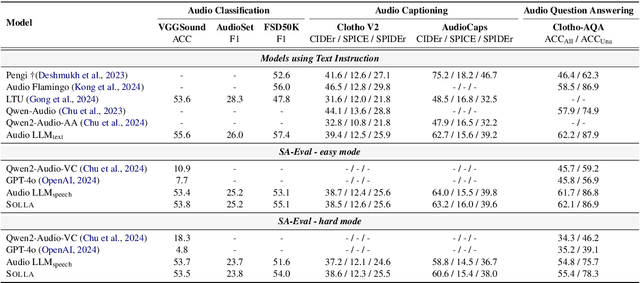
Abstract:Large Language Models (LLMs) have recently shown remarkable ability to process not only text but also multimodal inputs such as speech and audio. However, most existing models primarily focus on analyzing input signals using text instructions, overlooking scenarios in which speech instructions and audio are mixed and serve as inputs to the model. To address these challenges, we introduce Solla, a novel framework designed to understand speech-based questions and hear the acoustic context concurrently. Solla incorporates an audio tagging module to effectively identify and represent audio events, as well as an ASR-assisted prediction method to improve comprehension of spoken content. To rigorously evaluate Solla and other publicly available models, we propose a new benchmark dataset called SA-Eval, which includes three tasks: audio event classification, audio captioning, and audio question answering. SA-Eval has diverse speech instruction with various speaking styles, encompassing two difficulty levels, easy and hard, to capture the range of real-world acoustic conditions. Experimental results show that Solla performs on par with or outperforms baseline models on both the easy and hard test sets, underscoring its effectiveness in jointly understanding speech and audio.
Identifying Trustworthiness Challenges in Deep Learning Models for Continental-Scale Water Quality Prediction
Mar 13, 2025



Abstract:Water quality is foundational to environmental sustainability, ecosystem resilience, and public health. Deep learning models, particularly Long Short-Term Memory (LSTM) networks, offer transformative potential for large-scale water quality prediction and scientific insights generation. However, their widespread adoption in high-stakes decision-making, such as pollution mitigation and equitable resource allocation, is prevented by unresolved trustworthiness challenges including fairness, uncertainty, interpretability, robustness, generalizability, and reproducibility. In this work, we present the first comprehensive evaluation of trustworthiness in a continental-scale multi-task LSTM model predicting 20 water quality variables (encompassing physical/chemical processes, geochemical weathering, and nutrient cycling) across 482 U.S. basins. Our investigation uncovers systematic patterns of model performance disparities linked to basin characteristics, the inherent complexity of biogeochemical processes, and variable predictability, emphasizing critical performance fairness concerns. We further propose methodological frameworks for quantitatively evaluating critical aspects of trustworthiness, including uncertainty, interpretability, and robustness, identifying key limitations that could challenge reliable real-world deployment. This work serves as a timely call to action for advancing trustworthy data-driven methods for water resources management and provides a pathway to offering critical insights for researchers, decision-makers, and practitioners seeking to leverage artificial intelligence (AI) responsibly in environmental management.
TCM-3CEval: A Triaxial Benchmark for Assessing Responses from Large Language Models in Traditional Chinese Medicine
Mar 10, 2025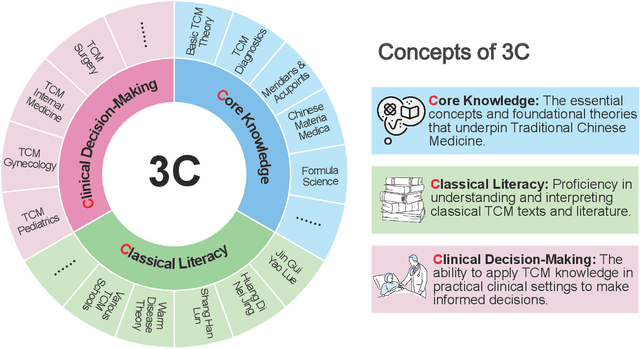
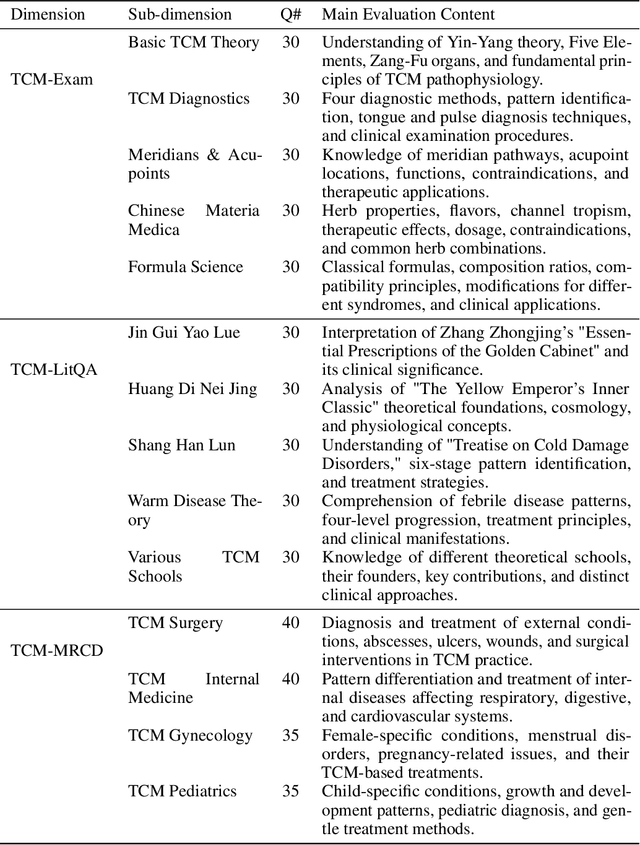
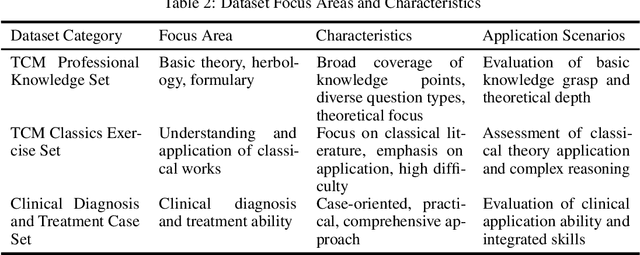

Abstract:Large language models (LLMs) excel in various NLP tasks and modern medicine, but their evaluation in traditional Chinese medicine (TCM) is underexplored. To address this, we introduce TCM3CEval, a benchmark assessing LLMs in TCM across three dimensions: core knowledge mastery, classical text understanding, and clinical decision-making. We evaluate diverse models, including international (e.g., GPT-4o), Chinese (e.g., InternLM), and medical-specific (e.g., PLUSE). Results show a performance hierarchy: all models have limitations in specialized subdomains like Meridian & Acupoint theory and Various TCM Schools, revealing gaps between current capabilities and clinical needs. Models with Chinese linguistic and cultural priors perform better in classical text interpretation and clinical reasoning. TCM-3CEval sets a standard for AI evaluation in TCM, offering insights for optimizing LLMs in culturally grounded medical domains. The benchmark is available on Medbench's TCM track, aiming to assess LLMs' TCM capabilities in basic knowledge, classic texts, and clinical decision-making through multidimensional questions and real cases.
Benchmarking Chinese Medical LLMs: A Medbench-based Analysis of Performance Gaps and Hierarchical Optimization Strategies
Mar 10, 2025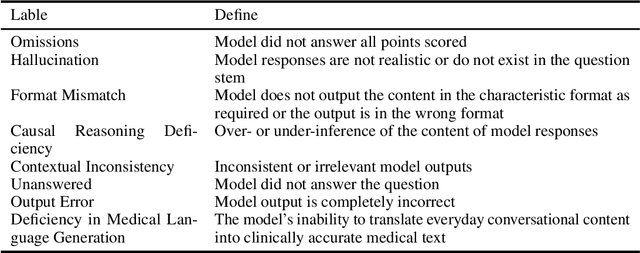
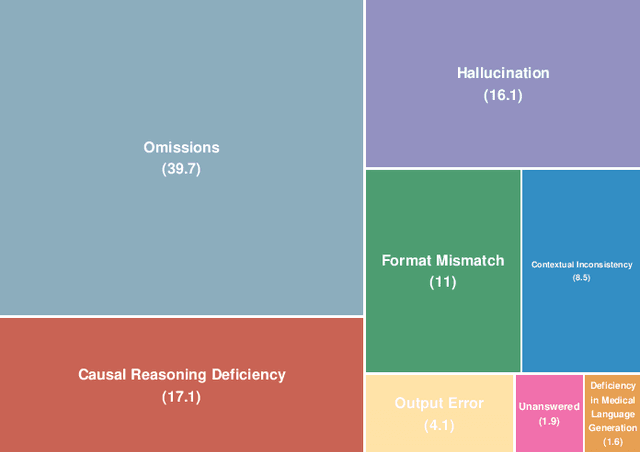

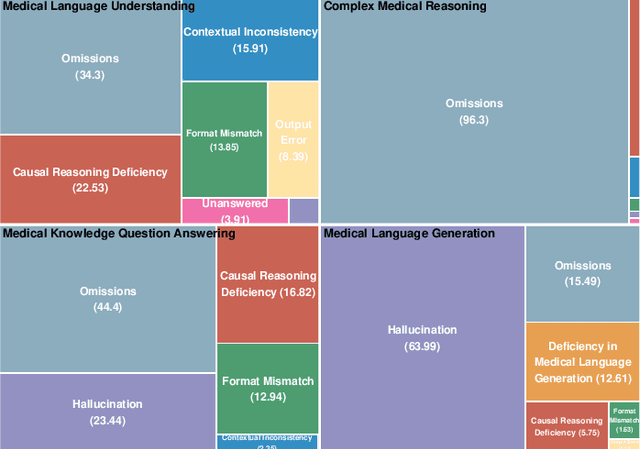
Abstract:The evaluation and improvement of medical large language models (LLMs) are critical for their real-world deployment, particularly in ensuring accuracy, safety, and ethical alignment. Existing frameworks inadequately dissect domain-specific error patterns or address cross-modal challenges. This study introduces a granular error taxonomy through systematic analysis of top 10 models on MedBench, categorizing incorrect responses into eight types: Omissions, Hallucination, Format Mismatch, Causal Reasoning Deficiency, Contextual Inconsistency, Unanswered, Output Error, and Deficiency in Medical Language Generation. Evaluation of 10 leading models reveals vulnerabilities: despite achieving 0.86 accuracy in medical knowledge recall, critical reasoning tasks show 96.3% omission, while safety ethics evaluations expose alarming inconsistency (robustness score: 0.79) under option shuffled. Our analysis uncovers systemic weaknesses in knowledge boundary enforcement and multi-step reasoning. To address these, we propose a tiered optimization strategy spanning four levels, from prompt engineering and knowledge-augmented retrieval to hybrid neuro-symbolic architectures and causal reasoning frameworks. This work establishes an actionable roadmap for developing clinically robust LLMs while redefining evaluation paradigms through error-driven insights, ultimately advancing the safety and trustworthiness of AI in high-stakes medical environments.
Active operator learning with predictive uncertainty quantification for partial differential equations
Mar 05, 2025Abstract:In this work, we develop a method for uncertainty quantification in deep operator networks (DeepONets) using predictive uncertainty estimates calibrated to model errors observed during training. The uncertainty framework operates using a single network, in contrast to existing ensemble approaches, and introduces minimal overhead during training and inference. We also introduce an optimized implementation for DeepONet inference (reducing evaluation times by a factor of five) to provide models well-suited for real-time applications. We evaluate the uncertainty-equipped models on a series of partial differential equation (PDE) problems, and show that the model predictions are unbiased, non-skewed, and accurately reproduce solutions to the PDEs. To assess how well the models generalize, we evaluate the network predictions and uncertainty estimates on in-distribution and out-of-distribution test datasets. We find the predictive uncertainties accurately reflect the observed model errors over a range of problems with varying complexity; simpler out-of-distribution examples are assigned low uncertainty estimates, consistent with the observed errors, while more complex out-of-distribution examples are properly assigned higher uncertainties. We also provide a statistical analysis of the predictive uncertainties and verify that these estimates are well-aligned with the observed error distributions at the tail-end of training. Finally, we demonstrate how predictive uncertainties can be used within an active learning framework to yield improvements in accuracy and data-efficiency for outer-loop optimization procedures.
 Add to Chrome
Add to Chrome Add to Firefox
Add to Firefox Add to Edge
Add to Edge